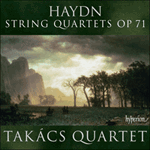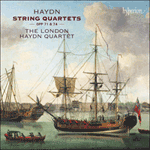
Welcome to Hyperion Records, an independent British classical label devoted to presenting high-quality recordings of music of all styles and from all periods from the twelfth century to the twenty-first.
Hyperion offers both CDs, and downloads in a number of formats. The site is also available in several languages.
Please use the dropdown buttons to set your preferred options, or use the checkbox to accept the defaults.
The theme of the slow movement, in siciliano-like rhythm, has the lower pair of instruments in a smooth, yearning ascent, and the first violin’s melody descending to meet them. Following a murmuring middle section that takes the music into ‘flatter’ regions, the initial melody returns, this time with its individual phrases prefaced by a grace note, like a kind of expressive glottal stop. In the closing bars, the murmuring sound of the middle section makes itself briefly felt again, before the music fades away into the distance.
The minuet shows Haydn’s wit at its most sophisticated, with the opening six-bar theme immediately restated in full, but harmonized entirely differently. Moreover, at the end, the music’s texture is inverted, so that the initial cello accompaniment now appears at the top, and the theme beneath it.
The finale is as energetic as the opening movement, with rapid repeated notes played by bouncing the bow off the string, and passages of gypsy exuberance that have syncopated inner parts and a drone-like bass line. If the central development section is unusually brief, Haydn more than makes amends by incorporating a lengthy developmental passage into the recapitulation, in a manner typical of his late style. Despite the high jinx of the piece as a whole, Haydn surprisingly allows it to draw to a pianissimo close—the only subdued ending to be found among the six ‘Salomon’ quartets.
from notes by Misha Donat © 2011
Le thème du mouvement lent, sur un rythme de sicilienne, fait monter les deux instruments graves dans une ascension douce et ardente alors que la mélodie du premier violon descend à leur rencontre. Après une section centrale murmurante qui entraîne la musique dans un univers «plus bémolisé», la mélodie initiale revient, cette fois avec ses phrases isolées préfacées par une petite note, comme une sorte de coup de glotte expressif. Dans les dernières mesures, le son murmurant de la section centrale se fait brièvement sentir à nouveau, avant que la musique s’évanouisse dans le lointain.
Le menuet nous montre le très grand raffinement de l’esprit de Haydn, avec le thème initial de six mesures immédiatement réexposé dans son intégralité, mais harmonisé de manière totalement différente. En outre, à la fin, la texture de la musique est inversée, si bien que l’accompagnement initial de violoncelle apparaît maintenant au sommet et le thème en dessous.
Le finale est aussi énergique que le premier mouvement, avec des notes répétées rapides jouées en faisant rebondir l’archet sur la corde, et des passages d’exubérance tzigane sur des parties internes syncopées et une basse en forme de bourdon. Si le développement central est exceptionnellement court, Haydn fait plus que s’amender en incorporant un développement assez long dans la réexposition, procédé typique du style de sa maturité. Malgré le côté folâtre de cette pièce dans son ensemble, Haydn lui permet, chose surprenante, de s’achever pianissimo—la seule fin contenue parmi les six quatuors «Salomon».
extrait des notes rédigées par Misha Donat © 2011
Français: Marie-Stella Pâris
Das Thema des langsamen Satzes im Siciliano-Rhythmus wird von den beiden tieferen Instrumenten weich und sehnsuchtsvoll aufsteigend gespielt; die Melodie der ersten Violine steigt dabei ab, sodass beide sich begegnen. Nach einem raunenden Mittelteil, in dem die Musik „gleichmäßiger“ wird, kehrt die Anfangsmelodie wieder, wobei den einzelnen Phrasen diesmal eine kurze Vorschlagsnote vorausgeht, etwa wie ein ausdrucksvoller Verschlußlaut. In den Schlußtakten ist das Raunen des Mittelteils wieder kurz zu hören, bevor die Musik in der Ferne verklingt.
Im Menuett zeigt sich Haydns Witz besonders verfeinert, indem das sechstaktige Anfangsthema sofort ganz wiederholt wird, nun aber völlig anders harmonisiert. Zudem wird am Schluß die Textur umgekehrt, sodass das die ursprüngliche Cello-Begleitung nun oben erscheint, und das Thema darunter.
Der Finalsatz ist ebenso dynamisch wie der Kopfsatz mit schnellen Tonwiederholungen, die durch Abprallen des Bogens von der Saite gespielt werden, und Passagen von zigeunerhaftem Überschwang mit synkopierten inneren Teilen und einer Bordun-ähnlichen Baßlinie. Ist der Hauptdurchführungsteil auch ungewöhnlich kurz, so macht Haydn das mehr als wett, indem er, typisch für seinen Spätstil, eine lange Durchführungspassage in die Reprise einbaut. Trotz des übermütigen Charakters des Werkes insgesamt läßt Haydn es überraschenderweise pianissimo ausklingen—der einzige gedämpfte Schluß, der sich unter den sechs „Salomon“-Quartetten findet.
aus dem Begleittext von Misha Donat © 2011
Deutsch: Christiane Frobenius
 Haydn: String Quartets Op 71 Haydn: String Quartets Op 71These quartets date from 1793 and were written when Haydn returned home to Vienna after a visit to London which had cemented his international fame as a composer and public figure. They possess an orchestral sonority—frequent modulations, dynamic ...» More |
 Haydn: String Quartets Opp 71 & 74 Haydn: String Quartets Opp 71 & 74The London Haydn Quartet brings all its usual attentive enthusiasm to these six late masterpieces.» More |

